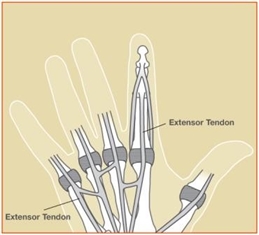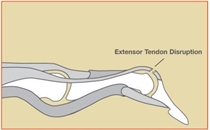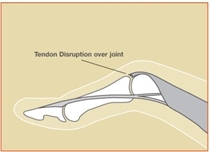Extensor Tendon Injuries

What is an extensor tendon?
Extensor tendons, located on the back of the hand and fingers, allow you to straighten your fingers and thumb. These tendons are attached to muscles in the forearm. As the tendons continue into the fingers, they become flat and thin. In the fingers, these tendons are joined by smaller tendons from the muscles in the hand. It is these small-muscle tendons that allow delicate finger motions and coordination.How are extensor tendors injured?
Extensor tendons are just under the skin, directly on the bone, on the back of the hands and fingers. Because of their location, they can be easily injured even by a minor cut. Jamming a finger may cause these thin tendons to rip apart from their attachment to bone. After this type of injury, you may have a hard time straightening one or more joints. Treatment is necessary to return use to the tendon.Figure 1: Extensor tendons, located on the back of the hand and fingers, allow you to straighten your fingers and thumb.
How are extensor tendon injuries treated?
Cuts that split the tendon may need stitches or surgical repair, but tears caused by jamming injuries are usually treated with splints. Splints stop the healing ends of the tendons from pulling apart and should be worn at all times until the tendon is fully healed. Your doctor will apply the splint in the correct place and give you directions on how long to wear it. Sometimes a pin is placed through the bone across the joint as an internal splint.

What are the common extensor tendon injuries?
Mallet finger refers to the droop of the end joint where an extensor tendon has been cut or separated from the bone (see Figure 2). Sometimes a piece of bone is pulled off with the tendon, but the result is the same: a fingertip that cannot be straightened. Whether the tendon injury is caused by a cut or jammed finger, splinting is necessary. Often the cut tendon requires stitches. Splinting is done to keep the fingertip straight until the tendon is healed. The size of the splint and length of time you will have to wear it is determined by the type and location of your injury. The splint should remain in place constantly during this time. The tendon may take four to eight weeks, or longer in some patients, to heal completely. Removing the splint early may result in drooping of the fingertip, which may then require additional splinting. Your physician will instruct you to remove the splint at the proper time.
Figure 2: The mallet finger deformity causes a droop of the fingertip. This is caused by injury to the extensor tendon at the last finger joint.
Boutonnière deformity describes the bent-down (flexed) position of the middle joint of the finger from a cut or tear of the extensor tendon (see Figure 3). Treatment involves splinting the middle joint in a straight position until the injured tendon is fully healed. Sometimes, stitches are necessary when the tendon has been cut. If this injury is not treated, or if the splint is not worn properly, the finger can quickly become even more bent-down and finally stiffen in this position. Be sure to follow your physician’s instructions and wear your splint for a minimum of four-to-eight weeks. Your doctor will tell you when you may stop wearing the splint.
Lacerations or cuts on the back of the hand that go through the extensor tendons cause difficulty in straightening the finger at the large joint where the fingers join the hand. These injuries are usually treated surgically by stitching the tendon ends together. Splinting for a tendon injury in this area may include the wrist and part of the finger. Dynamic splinting, which is a splint with slings that allows some finger motion, may be used for injuries of this kind. The dynamic splint allows early movement and protects the healing tendon.
What can I expect as a result of my extensor tendon injury?
Extensor tendon injuries may cause the tendon to attach itself to nearby bone and scar tissue. Many factors can affect the seriousness of the injury, including fracture, infection, and individual differences. The scar tissue that forms may prevent full-finger bending and straightening even with the best treatment. To improve motion, therapy may be necessary. Surgery to free scar tissue may sometimes be helpful in serious cases of motion loss. Your physician will explain the risks and side effects of the various treatments for extensor tendon injuries.

Figure 3: The boutonnière deformity with progressive flexion, or bending, of the middle joint may result in a stiff finger in this position if not treated. The end joint also hyperextends (bends backward) from the altered force across the finger.